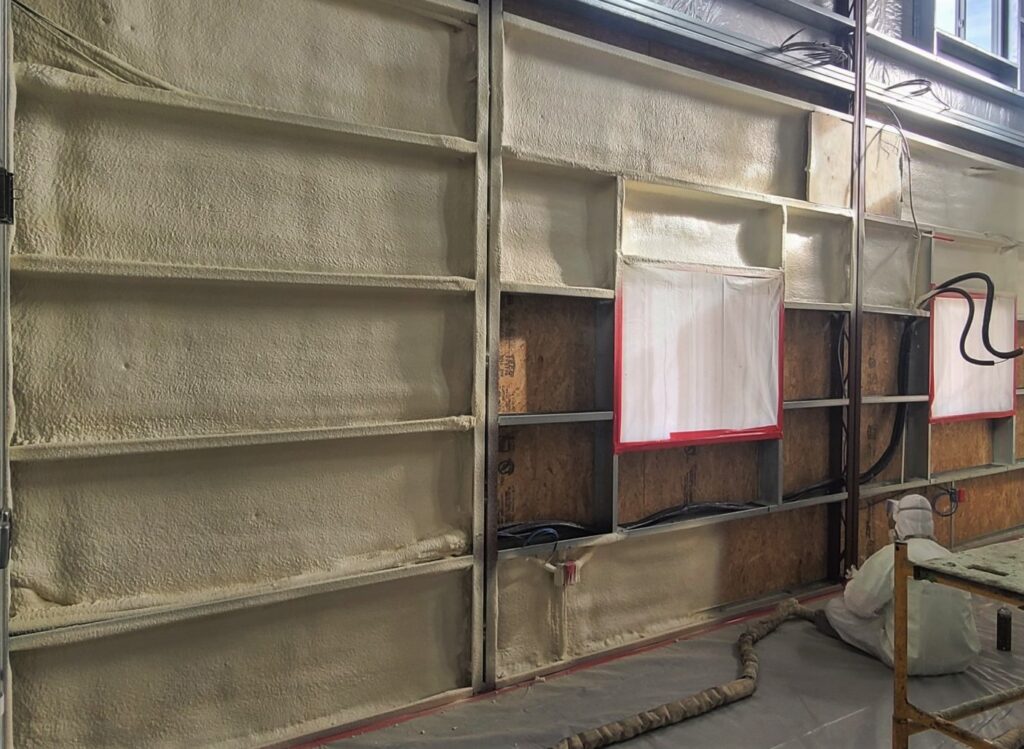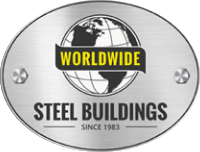« Blog Home
A Complete Guide to Spray Foam Insulation for Metal Buildings

Metal panels and roofs are crucial components in constructing durable and sustainable steel building envelope systems. However, these panels lack built-in insulation value, making it necessary to add insulation, air barriers, and vapor retarders to enhance energy efficiency.
When insulating your metal building, Spray polyurethane foam (SPF) insulation is a top choice for homeowners and subscribers seeking energy-efficient solutions. With its exceptional properties, including a superior thermal barrier, air-tight seal, and structural strength, closed-cell spray foam is the go-to insulation material for metal buildings.
To ensure SPF’s successful application and performance on metal panels, following best practices and design considerations is essential. In this comprehensive guide, we will delve into the benefits, installation, and concerns of using spray foam insulation to optimize energy savings, improve air quality, and ensure the longevity of your metal building.
Understanding Spray Foam Insulation
SPF insulation is a two-component chemical mixture that is sprayed onto metal panels. Unlike traditional fiberglass insulation, spray foam conforms to any substrate, including metal panels and roofs, filling even the tiniest crevices. The foam undergoes an exothermic reaction during curing, reaching core temperatures as high as 325°F for short periods. This seamless application creates a continuous thermal and moisture barrier, preventing heat transfer and minimizing the risk of mildew or moisture-related issues. Closed-cell SPF is the commonly used type of foam insulation on metal panels due to its superior insulation and water-resistant properties.
Differentiating Open-Cell and Closed-Cell Foam
There are two classes of SPF products: open-cell and closed-cell foam. Open-cell SPF provides insulation and air sealing for building assemblies but allows water migration and moisture vapor movement. Closed-cell SPF, on the other hand, offers superior insulation and prevents water entry and excessive moisture vapor movement. Closed-cell SPF is recommended for applications on metal panels.
Advantages of Spray Foam Insulation for Metal Buildings
- Superior Energy Efficiency: Closed-cell spray foam insulation offers a higher R-value than other insulation options, ensuring maximum energy efficiency and reducing energy costs for metal buildings.
- Enhanced Thermal Barrier: With its air-tight seal, closed-cell spray foam acts as a formidable thermal barrier, preventing heat transfer through metal walls and roofs. This insulation type significantly reduces energy loss and provides consistent temperature control inside the building.
- Air Quality Improvement: By sealing gaps and cracks, spray foam insulation improves indoor air quality by preventing the infiltration of pollutants, allergens, and outdoor contaminants into the metal building.
- Structural Strength: Closed-cell spray foam adds structural integrity to metal buildings, reinforcing the walls and roofs. This insulation type increases the overall durability and longevity of the structure.
10 Best Practices for SPF Insulation on Metal Panels
- Recommended applications: SPF is recognized as an insulation material suitable for use below and in contact with through-fastened metal roof assemblies.
- Caution with standing seam metal roofs: It is discouraged to use SPF below and in contact with standing seam metal roofs designed for thermal expansion and contraction, as it may restrict panel movement during temperature changes.
- Surface preparation: Ensure the metal panel surface is free from moisture, lubricants, dirt, or other contaminants before applying SPF.
- Application technique: The technique used to apply SPF can impact the performance and appearance of the foamed panels. Follow the recommended “picture frame” technique to achieve optimum insulation density, adhesion, and thickness.
- Avoid using release fabric membrane: Using a release fabric membrane between foam and metal panels in a wall assembly is not recommended, as it may create voids between the SPF and the panel.
- Minimize stress-induced deformation: Be aware that stress-induced deformation, commonly known as “oil canning,” may occur on 29 gauge or thinner material. Follow the foam manufacturer’s recommended application technique to minimize this effect.
- Fire protection and thermal performance: Always comply with national and local code requirements for fire protection. Exposed SPF may require additional thermal barriers or fire protection measures. Ensure compliance with energy code requirements for thermal performance.
- Collaboration with contractors: Inform electrical and HVAC contractors about the use of SPF to prevent covering junction boxes and to ensure proper sizing of equipment and adequate make-up air provision. Prevent SPF chemicals from being drawn into the building’s ventilation system.
- Engage certified SPF contractors: Consider hiring SPF contractors accredited by the Spray Polyurethane Foam Alliance’s (SPFA) Professional Certification Program (compliant with ISO 17024) to ensure high-quality and safe installation of SPF insulation.
- Consult with metal panel system manufacturer: Before applying SPF, consult with the metal panel system manufacturer to obtain specific recommendations and guidance.
Application Technique for Spray Foam Insulation on Metal Panels
When insulating metal buildings with spray polyurethane foam (SPF), the application technique is key in achieving optimal insulation density, adhesion, and thickness. To ensure a successful installation, it is important to have a certified foam spray technician handle the process. The recommended approach for applying SPF is the “picture frame” technique, as described by the Spray Polyurethane Foam Alliance (SPFA).
In the “picture frame” technique, the applicator surrounds the wall framing stud’s interior perimeter with a controlled foam thickness, allowing it to rise along the stud. This method ensures proper insulation and prevents SPF from getting between girts and architectural metal wall panels, which could lead to metal deformation.
During the application, the applicator should pay attention to the thickness of the initial pass fillet. It should be at least 0.5 inch and should not exceed the maximum pass thickness recommended by the foam manufacturer. This initial pass thickness is specified to provide enough material to activate the blowing agent and initiate the curing process. After picture framing the perimeter of the area, the applicator then fills in the center of the cavity using the maximum thickness recommended by the foam manufacturer. The maximum pass thickness varies depending on the foam formulation and is provided in the technical data for each SPF product. It is important to follow the manufacturers’ installation instructions on pass thickness limits and proper cooling times between subsequent passes to achieve the desired total thickness of insulation.
Before applying the SPF, installers are trained to inspect the substrate surface for moisture, dirt, oils, rust, or any other conditions that could interfere with proper foam adhesion. Adhesion to the metal surface can be determined on-site using a pull-tester per ASTM D 4541, a standard test method for the pull-off strength of coatings using portable adhesion testers.
Some SPF contractors may use a release material such as building wrap or fabric to replace damaged panels easily. However, using a release material may create air gaps between the back of the SPF foam and the metal panel, leading to potential condensation accumulation between the SPF and the panel and framing members. As a result, caution should be exercised when considering using release materials during the application process.
An alternative method evaluated by the Metal Construction Association (MCA) is the Blown In Blanket System (BIBS) non-woven fabric system. While SPF adhered properly to the BIBS membrane and allowed easier replacement of metal panels, it proved challenging to install directly onto the lightweight BIBS fabric in windy conditions. As a result, SPF applied directly onto the metal panels remains a more viable and efficient option in terms of the appearance of the panels.
Moving Forward with SPF Insulation
Insulating your metal building with Closed-cell Spray Polyurethane Foam insulation offers numerous benefits, from energy efficiency and cost savings to improved air quality and structural strength. Closed-cell spray foam provides an exceptional thermal barrier, air-tight seal, and moisture resistance, making it the best insulation choice for metal buildings. By creating a comfortable and efficient environment, spray foam insulation ensures long-lasting performance and protects your investment.
You can ensure a successful SPF insulation project on metal panels by following best practices and design considerations outlined in this guide, such as proper surface preparation, recommended application techniques, and collaboration with certified SPF contractors. Always consult with the metal panel system manufacturer for specific recommendations and guidelines. With its many advantages, spray foam insulation is the ideal solution for maximizing the energy efficiency and durability of your metal building.
For more information on spray polyurethane foam insulation and its application on metal panels, visit the Spray Polyurethane Foam Alliance (SPFA) website at www.sprayfoam.org.




